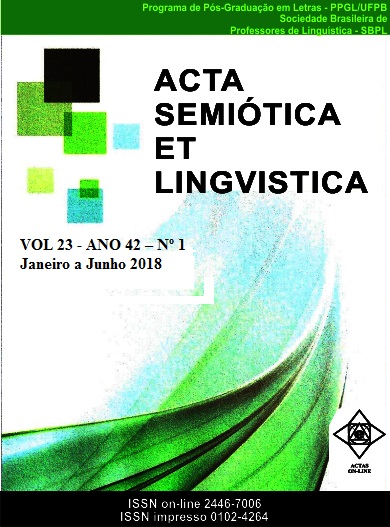UMA LEITURA SEMIÓTICA DE TESMOFORIANTES DE ARISTÓFANES A SEMIOTIC READING OF ARISTOPHANES’ THESMOPHORIASUZAE
DOI:
https://doi.org/10.22478/ufpb.2446-7006.2018v23n1.43361Resumo
O presente trabalho tem como objetivo analisar a estrutura da peça Tesmoforiantes (411 a. C.) do comediógrafo grego Aristófanes (447 a.C – 385 a. C.) à luz da semiótica greimasiana ou discursiva de origem francesa. Para isso, utilizaremos os estudos de Fiorin (2013) e Barros (2008), nos quais poderemos encontrar o modelo de análise que aplicaremos aqui, seguindo o percurso gerativo do sentido. Nosso trabalho, dessa forma, será dividido em três partes. Inicialmente, serão feitas algumas considerações sobre a comédia antiga e a obra em estudo. Na segunda parte, partiremos do nível fundamental do sentido para então estabelecermos as relações primordiais do texto, ligadas às oposições fundamentais que norteiam a obra de Aristófanes. Na terceira e última parte, nosso enfoque estará voltado para o nível narrativo, em que poderemos ver, com mais profundidade, o procedimento de cada uma das personagens e suas dimensões significativas dentro da obra. Além dos estudos semióticos, utilizaremos ainda as obras de Slater (2002), Pompeu (2011) e Sousa e Silva (1987), para a análise de outros elementos essenciais da peça. A partir deste artigo, podemos concluir que o teatro de Aristófanes é constituído por uma reflexão, ao mesmo tempo política e literária, do século V a. C. e que a análise semiótica se constitui como uma importante ferramenta epistemológica para a compreensão das estruturas e do sentido dessa obra.Palavras-chave: Semiótica discursiva; Aristófanes; Comédia Antiga; Tesmoforiantes
Abstract. The aim of this work is to analyze the structure of the play Thesmophoriazusae (411 BC), accomplished by the Greek comic playwright Aristophanes (447 BC – 385 BC), in light of the Greimasian semiotic theory aka French discursive semiotics. To achieve this purpose, we will base our analysis on the works done by Fiorin (2013) and Barros (2008), in which we can find the ideal analysis model to be applied here, following the generative path of meaning. In so doing, our work will be divided into three parts. Initially, some considerations will be made about the Ancient Comedy and the specific play which is the focus of this article. In the second part, we will start from the fundamental level of meaning and then establish the primordial relations within the text, linked to the fundamental oppositions that guide Aristophanes’ works. In the third and final part, our focus will be on the narrative level, in which we can analyze more deeply the attitudes of each of the characters and their significant dimensions within the play. Besides the semiotic studies, we will also refer to the works of Slater (2002), Pompeu (2011) and Sousa e Silva (1987), as far as the analysis of other essential elements of the above-mentioned play is concerned. This article allows us to conclude that Aristophanes’ theatrical comedy is constituted by a both political and literary reflection of the 5th century BC, and that the semiotic analysis constitutes an important epistemological tool for the understanding of the structures and meaning of the above-mentioned play. Keywords: Discursive semiotics; Aristophanes; Ancient Comedy; Thesmophoriazusae
Downloads
Downloads
Publicado
Edição
Seção
Licença
Declaração de Direito Autoral
Os artigos submetidos a revista Acta Semiotica et Lingvistica estão licenciados conforme CC BY. Para mais informações sobre essa forma de licenciamento, consulte: http://creativecommons.org/licenses/by/4.0
A disponibilização é gratuita na Internet, para que os usuários possam ler, fazer download, copiar, distribuir, imprimir, pesquisar ou referenciar o texto integral dos documentos, processá-los para indexação, utilizá-los como dados de entrada de programas para softwares, ou usá-los para qualquer outro propósito legal, sem barreira financeira, legal ou técnica.
1) Autores mantém os direitos autorais e concedem à revista o direito de primeira publicação, com o trabalho simultaneamente licenciado sob a Licença Creative Commons Attribution que permite o compartilhamento do trabalho com reconhecimento da autoria e publicação inicial nesta revista.
2) Autores têm autorização para assumir contratos adicionais separadamente, para distribuição não-exclusiva da versão do trabalho publicada nesta revista (ex.: publicar em repositório institucional ou como capítulo de livro), com reconhecimento de autoria e publicação inicial nesta revista.
3) Autores têm permissão para publicar e distribuir seu trabalho online (ex.: em repositórios institucionais ou na sua página pessoal) a qualquer ponto antes ou durante o processo editorial, já que isso pode gerar alterações produtivas, bem como aumentar o impacto e a citação do trabalho publicado.


